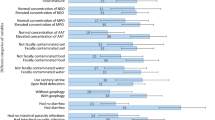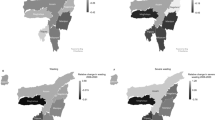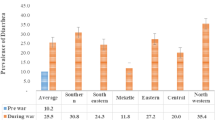Abstract
Objective:
A comprehensive, multiround survey of local food systems in a rickets-endemic area of Bangladesh was conducted to identify household-level risk factors for rickets.
Design:
A household-level, case–control study was conducted in a rickets-endemic area, Chakaria, with planned comparisons between households with one or more rachitic child and neighboring households with no affected children.
Setting:
A rickets-endemic area of southeastern Bangladesh, Chakaria.
Subjects and methods:
An interview-based survey was conducted in six villages in Chakaria with 199 households with at least one child showing physical signs consistent with rickets and 281 households with no affected children.
Results:
Households with rachitic children in Chakaria had more children, more pregnant or lactating women, and fewer adults than unaffected households in that community. Affected households tended to rely on farming for their livelihood and tended to have less economic activity as indicated by less outstanding debt than their neighbors. Households with rickets were at significantly greater risk of pneumonia than were other households. Calcium undernutrition was severe and widespread in Chakaria due to a food system that offered very little of the element in accessible forms. Household diets were based on cereals and starchy vegetables. Rice and fish constituted the major source of calcium for most households, although dairy products, when used, were very important calcium sources, particularly for young children. In fact, the use of dairy products was the only household choice that led to substantial increases in the calcium intakes of children, and households that used dairy products tended to show increased calcium intakes for all of their members.
Conclusions:
The risk of a Chakarian household having a child with rickets appeared to be related to its economic status. Although this might be expected to be manifest as limitations in food access and/or use, rickets households failed to show a dietary pattern associated with rickets. Calcium undernutrition was prevalent and, thus, would appear to be a predisposing factor for rickets; however, calcium undernutrition was prevalent in Chakarian households with and without rickets. Therefore, it is probable that another precipitating factor(s) play a role(s) in the etiology of rickets in Chakaria.
This is a preview of subscription content, access via your institution
Access options
Subscribe to this journal
Receive 12 print issues and online access
$259.00 per year
only $21.58 per issue
Buy this article
- Purchase on Springer Link
- Instant access to full article PDF
Prices may be subject to local taxes which are calculated during checkout


Similar content being viewed by others
References
Ahmad K & Hassan N (1983): Nutrition Survey of Rural Bangladesh 1981/82. Dhaka Bangladesh: Institute of Nutrition and Food Science, University of Dhaka, 63pp.
Anonymous (1998): Report of the Prevalence Study on Rickets in Children of Chakaria. Dhaka, Bangladesh: Institute of Child and Mother Health, 47pp.
Banajeh SM, al-Sunbali NN & al-Sanahani SH (1997): Clinical characteristics and outcome of children aged under 5 y hospitalized with severe pneumonia in Yemen. Ann. Trop. Paediatr. 17, 321–326.
Berg J (1990): Zinc fingers and other metal-binding domains. J. Biol. Chem. 265, 6513.
Bishop N (2001): The global burden of rickets. In Proceedings of the International Symposium on Improving Health and Economic Development: Approaches to Preventing Diet-Related Rickets, ed. GF Combs Jr, Ithaca, NY: Cornell International Institute of Food, Agriculture Development, pp 18–22.
Eugster EA, Sane KS & Brown DM (1996): Minnesota rickets. Need for a policy change to support vitamin D supplementation. Minn. Med. 79, 29–32.
Fischer PR, Rahman A, Cimma JP, Kyaw-Myint TO, Kabir ARML, Talukder K, Hassan N, Manaster BJ, Staab DB, Duxbury JM, Welch RM, Meisner CA, Haque S & Combs GF (1999): Nutritional rickets without vitamin D deficiency in Bangladesh. J. Trop. Pediatr. 45, 291–293.
Fraser DR & Tserendolgor U (2001): Rickets in Northern Asia. In Proceedings of the International Symposium on Improving Health and Economic Development: Approaches to Preventing Diet-Related Rickets, ed. GF Combs Jr, Ithaca, NY: Cornell International Institute of Food, Agriculture Development, pp 23–26.
Harris NS, Crawford PB, Yangzom Y, Pinzo L, Gyaltsen P & Hudes M (2001): Nutritional and health status of Tibetan children living at high altitudes. N. Engl. J. Med. 344, 341–347.
Hegsted M, Keenan MJ, Siver F & Wozniak P (1991): Effect of boron on vitamin D deficient rats. Biol. Trace Elem. Res. 28, 243–256.
Hill ID, Hassan N, Karim R & Duthie MR (1988): Tables of Nutrient Composition of Bangladesh Foods: English Version with Particular Emphasis on Vitamin A Contents. Bangladesh: Helen Keller International and United Nations World Food Program, 45pp.
Hunt CD & Idso J (1992): Dietary boron independent of vitamin D3 nutriture affects the morphology of the mineralization zone of the chick proximal tibial growth plate. J. Bone Min. Res. 7, S261–S269.
Karim F, Chowdhury AMR & Gani MS (2001): Rapid assessment of the endemicity of lower limb clinical rickets in Cox's Bazaar District of Bangladesh. In Proceedings of the International Symposium on Improving Health and Economic Development: Approaches to Preventing Diet-Related Rickets, ed. GF Combs Jr, Ithaca, NY: Cornell International Institute of Food, Agriculture Development, pp 44–54.
Kreiter SR, Schwartz RP, Kirkman Jr HN, Charlton PA, Calikoglu AS & Davenport ML (2000): Nutritional rickets in African American breast-fed infants. J. Pediatr. 137, 153–157.
Lin NU, Malloy PJ, Sakati N, al-Ashwal A & Feldman D (1996): A novel mutation in the deoxyribonucleic acid-binding domain of the vitamin D receptor causes hereditary 1,25-dihydroxyvitamin D-resistant rickets. J. Clin. Endcrinol. Metab. 81, 2564–2569.
Lutz W, Burritt MF, Nixon DE, Kao PC & Kumar R (2000): Zinc increases the activity of vitamin D-dependent promoters in osteoblasts. Biochem. Biophys. Res. Commun. 271, 1–7.
Majid Molla A, Badawi MH, al-Yaish S, Sharma P, el-Salam RS & Molla AM (2000): Risk factors for nutritional rickets among children in Kuwait. Pediatr. Int. 42, 280–284.
Mughal MZ, Salama H, Greenaway T, Laing I & Mawer EB (1999): Lesson of the week: florid rickets associated with prolonged breastfeeding without vitamin D supplementation. BMJ 318, 39–40.
Muhe L, Lulseged S, Mason KE & Simoes EA (1997): Case–control study of the role of nutritional rickets in the risk of developing pneumonia in Ethiopian children. Lancet 349, 1801–1804.
Murphy SP & Allen LH (2003): Nutritional Importance of Animal Source Foods. J. Nutr. 133, 3932S–3935S.
Oginni LM, Worsfold M, Oyelami OA, Sharp CA, Powell DE & Davie MWJ (1996): Etiology of rickets in Nigerian children. J. Pediatr. 128, 692–694.
Okonofua F, Gill DS, Alabi ZO, Thomas M, Bell JL & Dandona P (1991): Rickets in Nigerian children: a consequence of calcium malnutrition. Metabolism 40, 209–213.
Panel on Calcium and Related Nutrients (1997): Dietary Reference Intakes for Calcium, Phosphorus, Magnesium, Vitamin D and Fluoride. Washington, DC: National Academy Press, 432pp.
Panel on Folate, Other B Vitamins and Choline (1998): Dietary Reference Intakes for Thiamin, Riboflavin, Niacin, Vitamin B6, Folate, Vitamin B12, Pantothenic Acid, Biotin and Choline. Washington, DC: National Academy Press, 564pp.
Panel on Dietary Antioxidants and Related Compounds (2000): Dietary Reference Intakes for Vitamin C, Vitamin E, Selenium and Carotenoids. Washington, DC: National Academy Press, 506pp.
Panel on Micronutrients (2001): Dietary Reference Intakes for Vitamin A, Vitamin K, Arsenic, Boron, Chromium, Copper, Iodine, Iron, Manganese, Molybdenum, Nickel, Silicon, Vanadium and Zinc. Washington DC: National Academy Press, 773pp.
Pettifor JM, Ross P, Wang J, Moodley G & Couper-Smith J (1978): Rickets in children of rural origin in South Africa: Is low dietary calcium a factor? Pediatrics 92, 320–324.
Pugliese MT, Blumberg DL, Hludzinski J & Kay S (1998): Nutritional rickets in suburbia. J. Am. Coll. Nutr. 17, 637–640.
Shah M, Salhab N, Patterson D & Seikaly MG (2000): Nutritional rickets still afflict children in north Texas. Tex. Med. 96, 64–68.
Snedecor GW & Cochran WG (1967): Design and analysis of sampling, Chapter 1. In Statistical Methods. Ames, IA: The Iowa State University Press, pp 504–539.
Staab D, Kelly M & Dellagassa N (1999) unpublished research.
Subcommittee on the Tenth Edition of the RDAs (1989): Recommended Dietary Allowances, 10th Edition. Washington DC: National Academy Press, 284pp.
Thacher TD, Ighogboja SI & Fischer PR (1997): Rickets without vitamin D deficiency in Nigerian children. Ambulatory Child Health 3, 56–64.
Thacher TD, Fischer PR, Pettifor JM, Lawson JO, Isichei CO, Reading JC & Chan GM (1999): A comparison of calcium, vitamin D, or both for nutritional rickets in Nigerian children. N. Engl. J. Med. 341, 563–568.
Thacher TD, Fischer PR, Pettifor JM, Lawson JO, Manaster BJ & Reading JC (2000a): Radiographic scoring method for the assessment of the severity of nutritional rickets. J. Trop. Pediatr. 46, 132–139.
Thacher TD, Fischer PR, Pettifor JM, Lawson JO, Isichei CO & Chan GM (2000b): Case–control study of factors associated with nutritional rickets in Nigerian children. J. Pediatr. 137, 367–373.
Acknowledgements
This study was supported by the US Agency for International Development (USAID) through the Soil Management CRSP, and the Cornell International Institute for Food, Agriculture, and Development (CIIFAD). The authors are indebted to the families who gave of their time and hospitality for these interviews, and to their children who continue to provide the motivation for this work. We gratefully acknowledge the essential contributions of the following persons: Mr Andrew Daly, who served as field coordinator; Ms Afzalunessa, Ms Hamida Begum, Ms Momtaz Begum, Ms Salma Begum, Ms Farhana Haseen, Mr Md Khalequzzaman, Mr Manzur Morshed, Ms Lucky Parveen, Mr Mizanur Rahman, Mr Kazi Shahinur Rahman Depon, Ms Asia Siddiqua, who worked as field enumerators; Ms Jesmin Akhter, Ms Jesmin Begum, Mr Md Niamul Haque, Mr Md Saidul Islam, Mr Md Siddikur Rahman, who were data entry clerks; Mr Enamul Haque and Mr Masud Hasan, who provided data management; Mr Shahidul Haque and Mr Mohammed Noman, SARPV, who provided field support; Dr Mohammed Tapan, SARPV, who conducted medical examinations; Dr Phil Fischer, Mayo Clinic, Rochester, MN, USA, who provided advice concerning the health aspects of the survey; Dr Ed Frongillo, Cornell University, Ithaca, NY, USA, who provided advice concerning the statistical basis for the study design; Dr Craig Meisner, International Wheat and Maize Improvement Center, Bangladesh, who provided logistical support; Dr Fariba Roughead, Grand Forks Human Nutrition Research Center, USDA-ARS, and Dr Rebecca Stolzfus, Cornell University, whose comments were helpful in the preparation of this manuscript.
Author information
Authors and Affiliations
Corresponding author
Additional information
Guarantor: GF Combs.
Contributors: GFC was the principal investigator of the study; NH assisted in the planning of the survey and was responsible for implementing the survey
Rights and permissions
About this article
Cite this article
Combs, G., Hassan, N. The Chakaria food system study: household-level, case–control study to identify risk factor for rickets in Bangladesh. Eur J Clin Nutr 59, 1291–1301 (2005). https://doi.org/10.1038/sj.ejcn.1602242
Received:
Revised:
Accepted:
Published:
Issue Date:
DOI: https://doi.org/10.1038/sj.ejcn.1602242
Keywords
This article is cited by
-
Associations of drinking rainwater with macro-mineral intake and cardiometabolic health: a pooled cohort analysis in Bangladesh, 2016–2019
npj Clean Water (2020)
-
Apparent Efficacy of Food-Based Calcium Supplementation in Preventing Rickets in Bangladesh
Biological Trace Element Research (2008)



